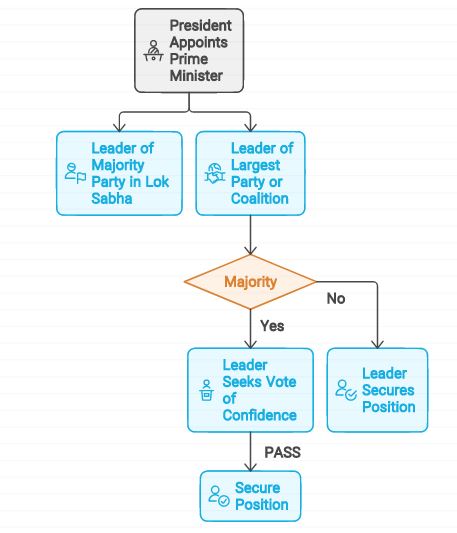From UPSC perspective, the following things are important :
Prelims level: Appointment of PM, Powers and Functions
Why in the News?
Narendra Modi will take the oath as the Prime Minister for a third consecutive term, following an invitation from President Droupadi Murmu to form the government.
Constitutional Provisions for PM Post
- Article 75: It states that the President shall appoint the Prime Minister, who is usually the leader of the majority party in the Lok Sabha (House of the People).
- Article 74: The Prime Minister is the head of the Council of Ministers and provides advice to the President on matters of governance.
Appointment of the Prime Minister
The appointment of the Prime Minister of India involves specific constitutional provisions supervised by the President. Key features related to the appointment of the Prime Minister as mentioned in the Constitution of India include:
- The Prime Minister is appointed permanently by the President of India.
- The President invites the leader of the majority party in the Lok Sabha to form the government.
- If no political party holds a majority, the President can use discretionary powers to appoint the Prime Minister.
- The President may invite the leader of the largest party or coalition to seek a vote of confidence from the Lok Sabha, with a tenure of about a month to secure this vote.

Position of Prime Minister in India’s Democratic set-up
- Head of Government: The Prime Minister is the chief executive authority in the country, responsible for leading the government and overseeing the functioning of various ministries and departments.
- Leader of the Council of Ministers: The Prime Minister is the leader of the Council of Ministers, which comprises cabinet ministers, ministers of state, and deputy ministers. They coordinate the activities of the government and guide policy decisions.
- Advisor to the President: While the President of India is the head of state, the Prime Minister acts as the president’s chief advisor and assists in exercising executive powers.
- Principal Link between President and Parliament: The Prime Minister communicates the decisions of the Council of Ministers to the President and represents the government in Parliament.
- Symbol of Unity and Stability: The Prime Minister symbolizes the unity and stability of the country’s governance. They provide leadership and direction to the nation, fostering a sense of unity and purpose among the citizens.
- International Representation: The Prime Minister represents India on the international stage and plays a significant role in foreign policy formulation. They engage in diplomatic relations, attend international summits, and represent India’s interests globally.
- Crisis Management: During times of crisis, such as natural disasters, security threats, or economic challenges, the Prime Minister takes charge of crisis management efforts and leads the government’s response to address the situation.
Powers and Functions of the Prime Minister
The Indian Constitution outlines the powers and functions of the Prime Minister, who is appointed by the President and holds significant authority over the President, Council of Ministers, and parliamentary houses. These powers include:
- Function Relative to the President: The Prime Minister serves as the main channel of communication between the President and the Council of Ministers, overseeing the administration of Union affairs and appointing key administrative officials.
- Functions Relative to the Council of Ministers: The Prime Minister advises on the nomination and selection of Council Ministers, can allocate and shuffle ministerial departments, and has the authority to demand resignations from ministers. The resignation of the Prime Minister leads to the dissolution of the Council of Ministers.
- Parliamentary Functions: The Prime Minister leads the lower parliamentary house (Lok Sabha), can suggest the dissolution of the Lok Sabha, and is responsible for announcing and introducing government policies in parliamentary sessions.
- Miscellaneous Functions: The Prime Minister holds additional roles such as chairman of the National Water Resource Council, NITI Aayog, National Integration Council, Inter-State Council, and NDA, among others.
Appointment, Tenure, and Removal
Eligibility: According to Articles 84 and 75 of the Constitution of India, the Prime Minister must:
- Be a citizen of India.
- Be a member of the Lok Sabha or the Rajya Sabha, or become a member within six months of selection.
- Be above 25 years of age if a Lok Sabha member, or above 30 years if a Rajya Sabha member.
- Not hold any office of profit under the government of India or any state government.
Oaths of Office and Secrecy:
Before entering office, the Prime Minister must take an oath of office and secrecy in the presence of the President of India, as per the Third Schedule of the Constitution.
Tenure and Removal from Office:
- The Prime Minister serves at the “pleasure of the President,” but must maintain the confidence of the Lok Sabha.
- The term can end if a simple majority of Lok Sabha members no longer have confidence in the Prime Minister, known as a vote of no-confidence.
- A Prime Minister can also resign from office. Morarji Desai was the first to do so while in office.
- Additionally, ceasing to meet the qualifications under the Representation of the People Act, 1951, can lead to removal from office.
PYQ:[2015] Consider the following statements:
Which of the statements given above is/are correct? (a) 1 only (b) 2 only (c) Both 1 and 2 (d) Neither 1 nor 2 [2019] Consider the following statements:
Which of the statements given above is/are correct? (a) 1 only (b) 2 only (c) Both 1 and 2 (d) Neither 1 nor 2 |
Get an IAS/IPS ranker as your 1: 1 personal mentor for UPSC 2024
